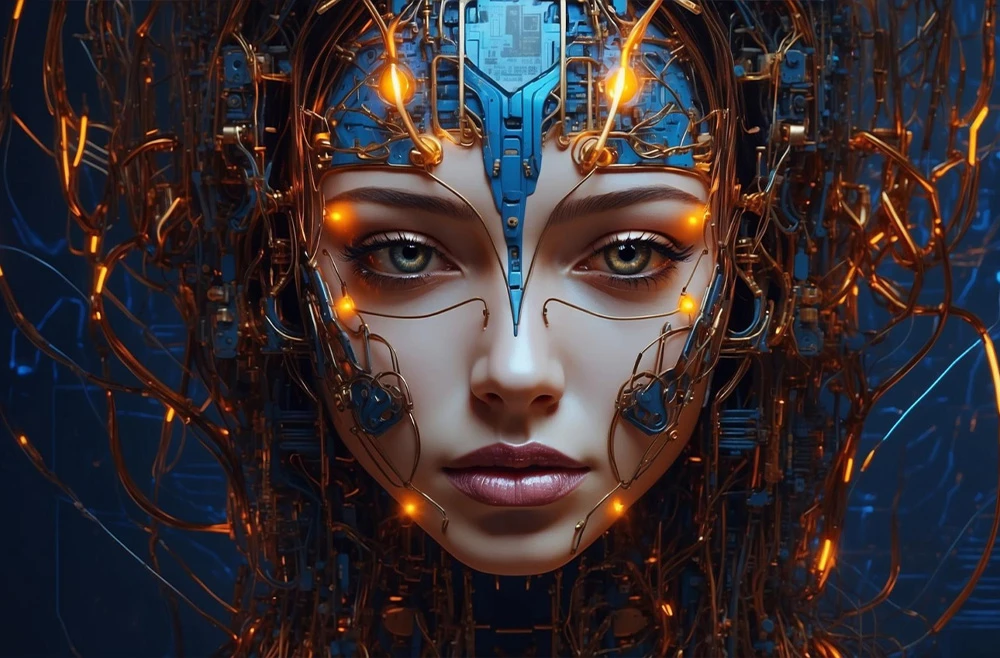Generative AI is a fascinating technology that acts like a smart artist on a computer, creating new things such as pictures or text by learning from examples. In simple terms, it's like having a computer that can be creative and generate content independently.
How Generative AI Works: The Basics
Generative AI uses intelligent algorithms to produce authentic-looking and sounding content, including images, text, and music. It operates like a classy brain, drawing inspiration from human-like minds and utilizing a neural network to analyze and process data.
Types of Generative AI Explained
1. Generative Adversarial Networks (GANs):
GANs bring together a generator and a discriminator in a creative dance. The generator produces new things, and the discriminator evaluates their quality, leading to realistic and creative outputs.
2. Variational Autoencoders (VAEs):
VAEs experiment with different styles, learning by reconstructing input data in various ways. They are great for generating diverse outputs within a given set of data.
3. AutoRegressive Models:
These models predict what comes next in a sequence, making them effective for tasks like language generation. GPT models fall into this category, creating coherent text passages based on context.
4. Boltzmann Machines:
Think of Boltzmann Machines as brainstorming buddies. They generate new ideas by considering relationships between different data points, often used in recommendation systems.
5. Transformer Models:
Transformers are multitasking magicians, handling different types of data. GPT models, a subset of transformers, excel in generating human-like text.
6. Deep Belief Networks (DBNs):
DBNs act like detectives uncovering hidden patterns in data, proficient in tasks like feature learning.
7. Creative Text-to-Image Models:
Some models specialize in transforming text descriptions into images, showcasing the intersection of language and image generation.
8. StyleGAN (Generative Adversarial Networks for Style Transfer):
StyleGAN allows artists to control the style of generated content, transferring artistic styles between images.
9. Recurrent Neural Networks (RNNs):
RNNs are like time-traveling storytellers, considering previous information when generating new content, suitable for tasks involving sequences.
10. Conditional Generative Models:
These models create outputs based on specific conditions or inputs, making them valuable for generating content tailored to particular requirements.
Generative NLP: Mastering Language with AI
Generative NLP, or Generative Natural Language Processing, is a subset of Generative AI that focuses on language. It acts like a digital wordsmith, understanding and generating human-like text. GPT models demonstrate the language mastery of Generative NLP.
Power of Transformer Learning Models in Generative AI
Transformers, at the heart of Generative AI, excel in parallel processing, making them highly efficient. They understand relationships between words, allowing them to generate coherent and contextually relevant content. Transformers, like GPT-3.5, are built on this architecture, demonstrating efficiency in language tasks.
Key Components of Transformers in Generative AI
1. Self-Attention Mechanism:
Allows the model to weigh different words differently based on relevance, capturing long-range dependencies in data.
2. Multi-Head Attention:
Employs multiple attention heads for parallelized attention, enhancing the model's ability to capture diverse patterns and dependencies.
3. Positional Encoding:
Provides an understanding of token positions in a sequence, addressing a limitation of the original Transformer architecture.
Power of Language Models in Generative AI
Language models, a subset of Generative AI, specialize in understanding and generating human-like text. GPT-3.5, with 175 billion parameters, is a potent example. These models go beyond mere understanding, producing coherent and contextually relevant text.
Key Components of Language Models in Generative AI
1. Attention Mechanism:
Weighs different words differently based on relevance, capturing dependencies and nuances.
2. Contextual Embedding:
Represents words considering the context in which they appear, adjusting their representation based on surrounding words.
3. Recurrent Neural Networks (RNNs) vs. Transformers:
RNNs process sequences incrementally, while Transformers excel in parallel processing, selecting based on task demands.
Transformers vs. Language Models: Decoding the Difference
While transformer learning models lay the groundwork for quick learning, language models serve as the expressive voice of Generative AI. Transformers focus on data processing efficiency and context understanding, while language models excel in language generation, making them adept storytellers.
Final Takeaway:
Generative AI holds endless possibilities, from reshaping design to revolutionizing language communication. However, with great power comes great responsibility. Addressing issues like bias and privacy ensures that Generative AI contributes positively to our digital world, fostering a creative revolution for the benefit of all.
Embrace the future of Generative AI technology, where innovation meets possibility. Join hands with leading tech companies to shape a future powered by limitless creativity.
Generative AI is a fascinating technology that acts like a smart artist on a computer, creating new things such as pictures or text by learning from examples. In simple terms, it's like having a computer that can be creative and generate content independently.
How Generative AI Works: The Basics
Generative AI uses intelligent algorithms to produce authentic-looking and sounding content, including images, text, and music. It operates like a classy brain, drawing inspiration from human-like minds and utilizing a neural network to analyze and process data.
Types of Generative AI Explained
1. Generative Adversarial Networks (GANs):
GANs bring together a generator and a discriminator in a creative dance. The generator produces new things, and the discriminator evaluates their quality, leading to realistic and creative outputs.
2. Variational Autoencoders (VAEs):
VAEs experiment with different styles, learning by reconstructing input data in various ways. They are great for generating diverse outputs within a given set of data.
3. AutoRegressive Models:
These models predict what comes next in a sequence, making them effective for tasks like language generation. GPT models fall into this category, creating coherent text passages based on context.
4. Boltzmann Machines:
Think of Boltzmann Machines as brainstorming buddies. They generate new ideas by considering relationships between different data points, often used in recommendation systems.
5. Transformer Models:
Transformers are multitasking magicians, handling different types of data. GPT models, a subset of transformers, excel in generating human-like text.
6. Deep Belief Networks (DBNs):
DBNs act like detectives uncovering hidden patterns in data, proficient in tasks like feature learning.
7. Creative Text-to-Image Models:
Some models specialize in transforming text descriptions into images, showcasing the intersection of language and image generation.
8. StyleGAN (Generative Adversarial Networks for Style Transfer):
StyleGAN allows artists to control the style of generated content, transferring artistic styles between images.
9. Recurrent Neural Networks (RNNs):
RNNs are like time-traveling storytellers, considering previous information when generating new content, suitable for tasks involving sequences.
10. Conditional Generative Models:
These models create outputs based on specific conditions or inputs, making them valuable for generating content tailored to particular requirements.
Generative NLP: Mastering Language with AI
Generative NLP, or Generative Natural Language Processing, is a subset of Generative AI that focuses on language. It acts like a digital wordsmith, understanding and generating human-like text. GPT models demonstrate the language mastery of Generative NLP.
Power of Transformer Learning Models in Generative AI
Transformers, at the heart of Generative AI, excel in parallel processing, making them highly efficient. They understand relationships between words, allowing them to generate coherent and contextually relevant content. Transformers, like GPT-3.5, are built on this architecture, demonstrating efficiency in language tasks.
Key Components of Transformers in Generative AI
1. Self-Attention Mechanism:
Allows the model to weigh different words differently based on relevance, capturing long-range dependencies in data.
2. Multi-Head Attention:
Employs multiple attention heads for parallelized attention, enhancing the model's ability to capture diverse patterns and dependencies.
3. Positional Encoding:
Provides an understanding of token positions in a sequence, addressing a limitation of the original Transformer architecture.
Power of Language Models in Generative AI
Language models, a subset of Generative AI, specialize in understanding and generating human-like text. GPT-3.5, with 175 billion parameters, is a potent example. These models go beyond mere understanding, producing coherent and contextually relevant text.
Key Components of Language Models in Generative AI
1. Attention Mechanism:
Weighs different words differently based on relevance, capturing dependencies and nuances.
2. Contextual Embedding:
Represents words considering the context in which they appear, adjusting their representation based on surrounding words.
3. Recurrent Neural Networks (RNNs) vs. Transformers:
RNNs process sequences incrementally, while Transformers excel in parallel processing, selecting based on task demands.
Transformers vs. Language Models: Decoding the Difference
While transformer learning models lay the groundwork for quick learning, language models serve as the expressive voice of Generative AI. Transformers focus on data processing efficiency and context understanding, while language models excel in language generation, making them adept storytellers.
Final Takeaway:
Generative AI holds endless possibilities, from reshaping design to revolutionizing language communication. However, with great power comes great responsibility. Addressing issues like bias and privacy ensures that Generative AI contributes positively to our digital world, fostering a creative revolution for the benefit of all.
Embrace the future of Generative AI technology, where innovation meets possibility. Join hands with leading tech companies to shape a future powered by limitless creativity.







